Scar Revision in Virginia, Washington D.C. and Maryland.
Embark on a journey of aesthetic excellence with The Naderi Center. Experience unparalleled artistry and precision for transformative beauty.
Experience the Benefits of Scar-Free Skin
Scar Revision isn’t just about skin correction—it’s about restoring one’s self-image and confidence. In a world where every mark tells a story, Dr. Kulak‘s approach at The Naderi Center is to ensure each narrative resonates beauty and strength.
Enhanced Appearance
Scar Revision subtly fades imperfections, revealing your skin's innate radiance.
Boosted Self-Esteem
With diminished scars, experience a resurgence in confidence and self-worth.
Advanced Techniques
Leveraging the latest in medical advancements, scar treatments offer minimal discomfort and optimal results, ensuring a seamless journey to rejuvenation.
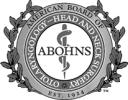


What is Scar Revision?
Scar revision procedures improve the overall appearance of a scar and helps to make it less noticeable. Acne, trauma or surgery are common causes of scarring. The likelihood for scar formation is a factor of age, genetics, anatomical location of the scar, skin type and the event that caused the scar.
Scar Revision Summary

Mild
MAC (monitored anesthesia care) or local anesthesia may be used or general anesthesia
30 to 45 minutes
“Z-plasty” or “Geometric Broken Line Closure” are techniques to realign scars
2 weeks
1 week
2 weeks
$2,000 – $5,000
Testimonial
Scar Types
Hypertrophic scars
Hypertrophic scars are thick, red, raised scars that often appear after a traumatic or a surgical wound site.
Keloids
Keloids are thick scars that usually appear larger than the wound itself and is more common on darker skin. Keloids are often found on the face, neck, ears and shoulders.
Contractures
Contractures are a type of scar that often restrict movement due to a large amount of skin being lost. This is common among burn victims.
Scars can have an effect on a patients physical and emotional wellbeing. Some scars can be itchy and irritating causing discomfort and sometimes pain. They can also alter one’s appearance leading to emotional implications. Facial scars can be especially distressing. It’s important to remember, a revised scar will not erase the scar, but instead help to make it less noticeable and better it’s overall appearance anywhere on the body.
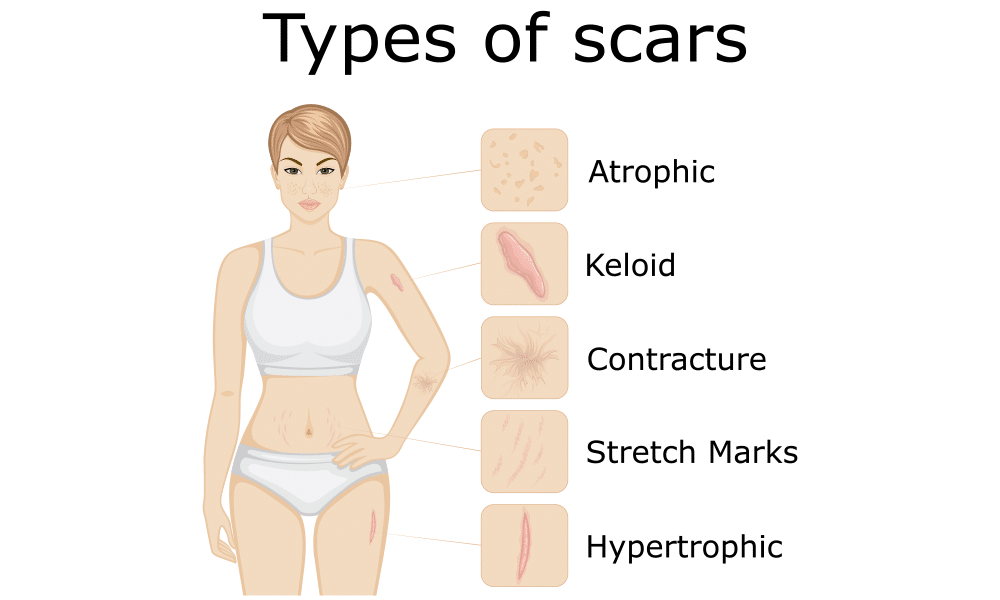
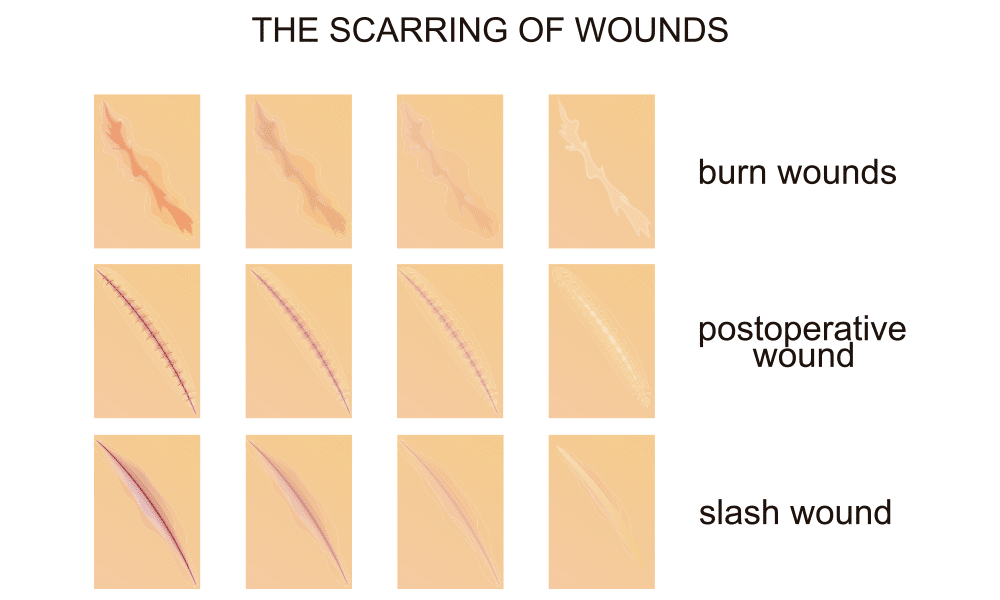
Ideal Candidate for Scar Revision
An ideal scar candidate for a scar revision:
- Scar color is similar to skin color around it
- Scar is level with skin and parallel to skin creases
- Have realistic expectations for scar improvement
Due to the tight growing skin in children, it is recommended that children who are in need of scar revisions wait until they are older. Lighter skinned patients also have an improved outcome than darker skin patients due to the pigmentation changes in dark skin. Resurfacing is also not always an option in darker skinned patients.

Techniques used in scar revision
The type of procedure will vary according to the scar. Scar revision can be a surgical or non-surgical procedure. Surgical techniques often include a “Z-plasty”, also called “Geometric Broken Line Closure”, skin grafts and tissue expanders.
Surgical Techniques for Scar Revision
Z Plasty
Z plasty is a procedure that involves repositioning scars so they are less visible and placed in a more favorable alignment. This may be followed by surfacing techniques such as chemical peels, laser resurfacing or dermabrasion.
M Plasty and W Plasty
M plasty and W plasty are similar techniques, but are result in different scar shapes and orientations depending on the desired orientation of the scar to make it least visible. W plasty is a more zip-zag shape and is often used to redistribute any tension along the scar and breaks up a more linear scar. The M plasty is usually used for the ends of scars to help prevent the dog ear formation. It can also shorten a scar at the end.
Linear Closure
For any elliptical or circular shaped scars, a linear closure technique can be used to make the scar more linear and therefore less visible. By using a small excision to cut some skin, a elliptical scar can be made more into an oval. This is then sealed together to form a more linear looking scar.
Skin Grafts
A Skin graft is another surgical technique that involves taking skin from one part of the body and transferring it to another part. This can be used for scar revision by taking healthy looking skin and placing it over the unsightly scar. This technique is often used for more severe scars.
Tissue Expansion
Tissue expanding is surgical technique in which the skin is stretched to allow it to grow over the scar. This works by removing the scar completely, inflating a “balloon” under the skin to stretch it and allowing the newly stretched skin cover where the scar just was.
Hair Grafts
Due to the nature of scars, hair growth is restricted from growing on scar tissue. This can make scars that are on the head or in hairy areas more noticeable. A hair graft can be done to cover up this scar and make it less noticeable. Hair follicles can be taken from a place where hair will grow back, and these follicles can be placed inside the scar. This works best on scars that are flatter and do not protrude form the skin.

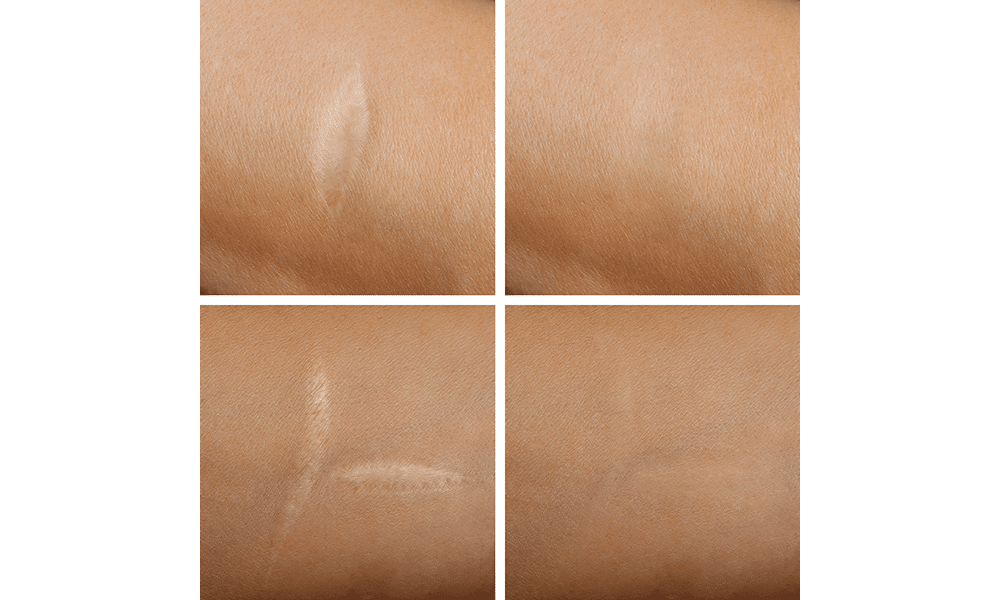
Non Invasive Techniques for Scar Revision
Some scars may only require nonsurgical procedures such as chemical peels, laser resurfacing or dermabrasion.
Chemical Peels
Chemical Peels remove the outermost layer of the skin to smooth the skin texture and help resurface the scar. A strong chemical peel, such as the Baker-Gordon phenol peel, will penetrate the deeper part of the dermal layer of the skin. The deep chemical peels will increase the body’s natural production of collagen in order to repair the affected skin and allow for complete regeneration of new healthy looking skin. Recovery from deep chemical peels can last a few weeks until the skin has healed completely.
Laser Resurfacing
Laser resurfacing is a technique used for deeper scars to remove the top layer of the skin and smooth out the scared area. CO2 laser is one type of laser that is effective in removing the outermost layer of skin, called the epidermis. CO2 lasers apply heat to the underlying layer of skin, known as the dermis, to stimulate growth of new collagen fibers. The hope is that the new layer of skin that grows back will be tighter, clearer and smoother than the former scar. An erbium laser is similar to the CO2 laser, but has a lower wavelength, so it acts more superficially to the skin and does not apply as much heat to the dermis layer. Erbium leasers are great for thinner skin as they allow for more depth penetration adjustments to be made. Erbium lasers help to even out skin tones and reduce and fine lines from scars.
Dermabrasion
Dermabrasion stimulates small doses of trauma to the skin to allow that area of the skin to repair itself and create a more smooth and healthier appearance. This is done using a rotating instrument that will remove the outermost layer of skin where the scar might me, which will allow new skin to grow in place of this removed outer layer of skin. Unlike microdermabrasion which is very minimal and has no downtime, actual dermabrasion is performed under general anesthesia and involves physically sanding down the skin to promote growth of new skin.
Steroid Injections
Steroid Injections can be used to soften and shrink scars such as keloid and hypertrophic scars. Often times steroid injections are used to prevent a keloid or hypertrophic scar from forming in the first place. Some scars can also create itching, burning or pain sensations, for which steroid injections help to reduce.



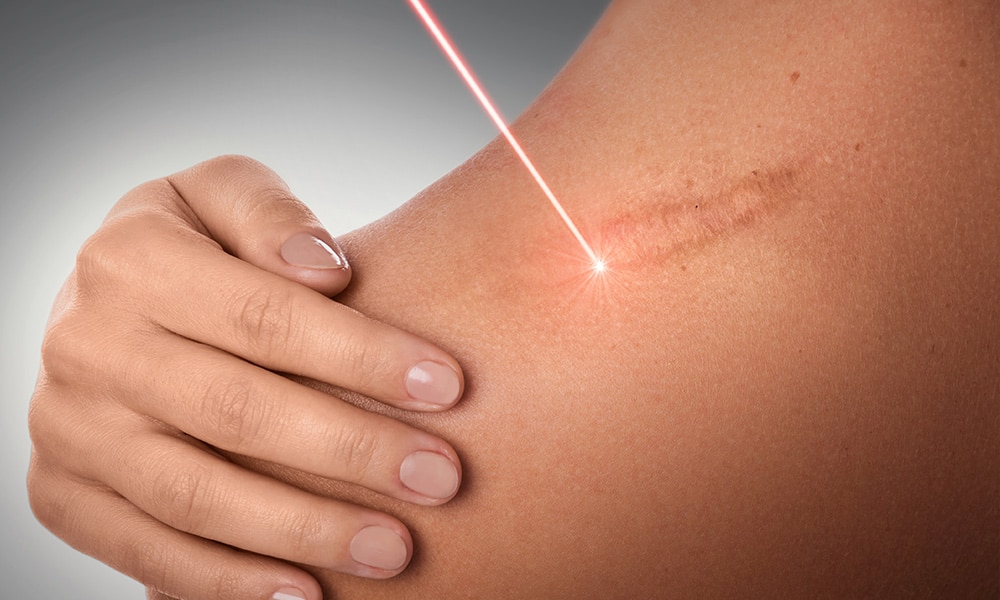
At Home Remedies for Scar Treatment
There are many topical products that can help speed up the scar healing process or help with its appearance. Silicone gel sheets, vitamin E and green tea extracts are some common topical creams that can help revise a scar and speed its healing process up in the right direction. Often times a special brown tape is prescribed after surgical procedures to ensure nice healing of a post-surgical scar.
What determines the approach for the scar revision?
Many factors contribute to the approach that is determined for the improvement of the scar. The size, location, and type of scar are all factors. Additionally, the laxity of the surrounding tissue, the availability of the surrounding tissue and if the scar is in close proximity to any vital areas (i.e. eyelids).
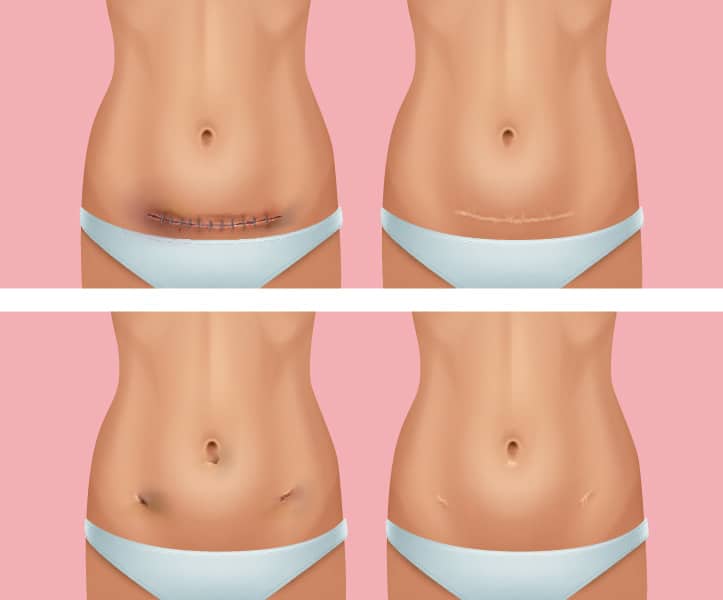
Why do scars form after surgery?
In any surgery, the actual surgery is of course very important, but making sure the incision is closed properly is just as important and can help the healing process and avoiding any long-term complications. An incision closure technique often dubbed the “plastic surgeons’ closure” is very important for proper wound healing and prevention of a non-aesthetic scar. This type of closure is often demanded in hospital settings for specific surgeries because it can prevent further complications.
A common issue many people face after surgery is the presence of “Dog Ears”. These form when skin surrounding a scar is much tighter than the rest of the surrounding skin causing it to pucker. This is very common after a breast reduction or a tummy tuck. Dog ears can be revised by removing a some of the tissue during a revision surgery.
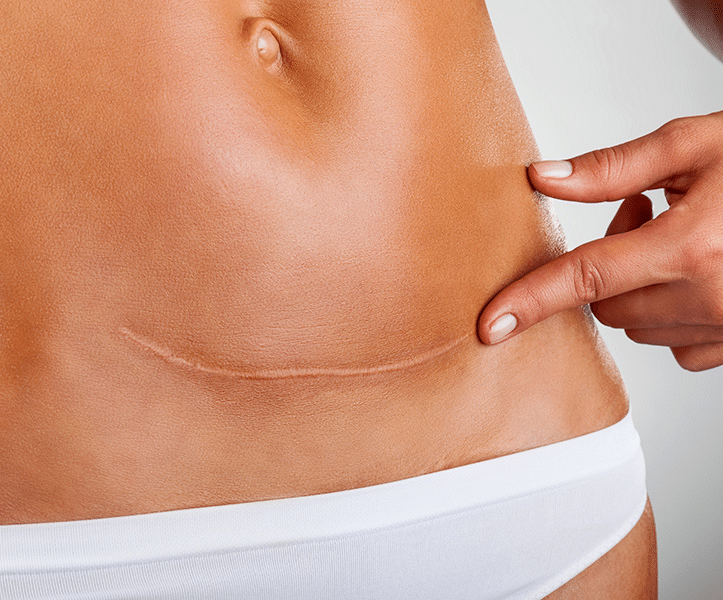
How do I know when my scar is ready for scar revision?
It is sometimes hard to know when a scar or wound has completely healed. Often during the healing process, a scar will appear light red or pink and will begin to fade over time. Once the scar stays as a constant appearance, this can indicate the wound has healed and scar revision may be able to be performed.
It is important to remember that these techniques are used to help with the appearance of the scar, but will not remove the scar. A scar that is not completely healed should not undergo revision. Additionally, scar revisions work better on adults and not on children.
Cost of Scar Revision
- Surgeons Fee: $2000 – $5,000
- Anesthesia Fee: dependent on whether local or general anesthesia is used
- Hospital and Surgical Facility Fees: depends on length of procedure
- Pre-Surgical Medical Clearance and Lab Tests: usually covered by medical insurance.
- Minor scar revisions do not require medical clearance.
- Medication Costs: usually covered by medical insurance
- Follow-Up Visits: included with surgeon’s fee at The Naderi Center
Preparing for Scar Revision
At the Naderi Center we believe proper preparation for surgery helps to optimize outcomes and improve results. If scar revision includes surgery, you may be asked to take certain medication, stop smoking prior to surgery and avoid taking any anti-inflammatory drugs or herbal supplements to prevent excessive bleeding. A local or general anesthesia may be used during your scar revision procedure. Final results after a scare revision may take weeks to months to realize.
Recovery after Scar Revision
Depending on the size and location of the scar most patients can go back to their regular routine within a few days to a week. It is important to not put tension on the scar in order to optimize its healing. Some swelling or bruising may occur as well as the incision will be red during the first days to weeks after surgery. In order to optimize surgical outcomes it is important that patients follow our treatment instructions.
Risks, Safety And Potential Complications After A Scar Revision
Risks that come with scar revision procedures are generally minimal when performed by expert and experienced medical professionals. Generally speaking one of the most disappointing scar revision outcomes is that the new scar is not as impressive of an improvement as was desired. When proper revision techniques are selected the risk for unimpressive results diminishes.
Possible Complications after a Scar Revision Include
- Reoccurrence of scar
- Keloid formation
- Delayed healing
- Skin discoloration and
- Infection
- Bleeding
- Sensation of itching, burning or pain
- Changes in normal skin sensation
Scar Revision Experts at The Naderi Center
Depending on the location of your scar our consultation coordinators will direct you to which one of our board-certified surgeons is the best fit for your scar revision. Dr. Jessica Kulak, a double board-certified facial plastic surgeon specializes exclusively in cosmetic facial procedures. Dr. Kulak has extensive experience with scar revisions and is well-versed in which scar revision techniques work best in specific situations.
To find out if a scar revision is the right procedure for you, contact The Naderi Center to schedule a consultation. Contact our Reston, Virginia office at 703-481-0002 or the Chevy Chase, Maryland office at 301-222-2020. Although the Naderi Center is conveniently located for patients throughout the Virginia, Maryland, and Washington D.C. area, we have many patients from across the United States who come to our surgeons because they know they are ultra-specialized in their area of cosmetic plastic surgery. Those outside of the immediate area may request a virtual consultation with our specialist.

Scar Revision FAQs
Can You Repair Scars on My Face?
Yes, we offer several scar revision treatments including scar revision surgery, microneedling, laser therapy, and steroid injections. Each treatment is tailored to your scar type, location, and severity. Please schedule a consultation to discuss your options.
How long should I wait for scar revision?
It is recommended to wait at least 6-12 months after the initial injury or surgery before considering scar revision. This allows the scar tissue to fully mature and gives the best chance for optimal results from the revision procedure. It is important to consult with a board-certified surgeon at The Naderi Center to determine the best timing for your specific situation.
How many scar revision techniques are there?
There are several scar revision techniques available, each designed to address specific types of scarring. Some common techniques include excision, where the scar is surgically removed and the wound closed with minimal tension to create a finer scar; laser resurfacing, which uses laser technology to remove the top layers of skin and stimulate collagen production for smoother skin; dermabrasion, which involves removing the top layer
Is scar revision surgery worth it?
Yes, scar revision surgery can be worth it for many individuals who are bothered by the appearance of their scars. It can improve the overall look and texture of the scar, leading to increased confidence and self-esteem. However, it is important to consult with a board-certified surgeon at The Naderi Center to discuss the potential risks and benefits, as well as realistic expectations for the outcome of the procedure. Ultimately, the decision to undergo scar revision surgery should be based on individual needs and goals.
What Scar Revision Office Is Near Me?
If you live in the states of Virginia or Maryland, The Naderi Center for Plastic Surgery and Dermatology offers scar revision among its services. For a full list of services, please visit our Locations page.

